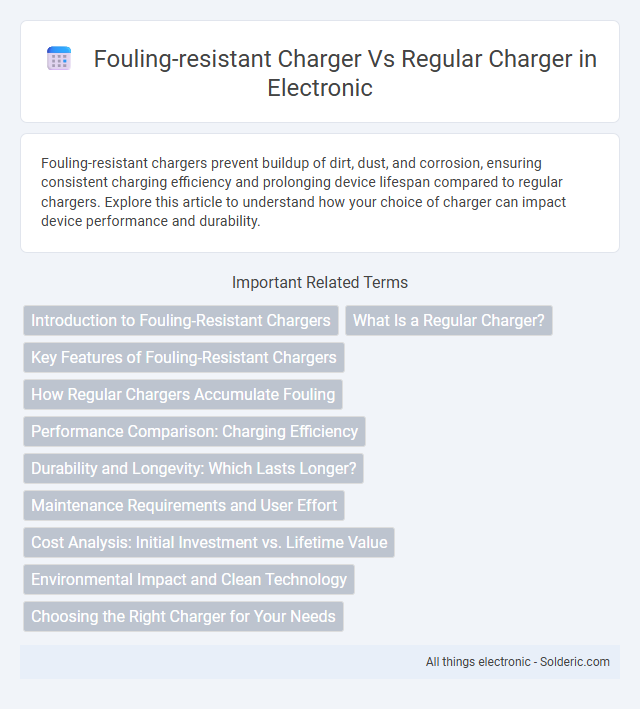Fouling-resistant chargers prevent buildup of dirt, dust, and corrosion, ensuring consistent charging efficiency and prolonging device lifespan compared to regular chargers. Explore this article to understand how your choice of charger can impact device performance and durability.
Comparison Table
| Feature | Fouling-Resistant Charger | Regular Charger |
|---|---|---|
| Fouling Resistance | High resistance to dirt, dust, and debris buildup | Prone to fouling and dirt accumulation |
| Charging Efficiency | Maintains consistent charging speed even in harsh conditions | Charging speed decreases due to fouling |
| Durability | Enhanced lifespan with corrosion-resistant materials | Standard materials with average durability |
| Maintenance | Low maintenance, fewer cleanings required | Regular cleaning needed to prevent fouling |
| Cost | Higher initial cost | Lower upfront cost |
| Use Case | Ideal for outdoor, industrial, or harsh environments | Suitable for indoor or clean environments |
Introduction to Fouling-Resistant Chargers
Fouling-resistant chargers incorporate advanced materials and coatings designed to prevent the buildup of dirt, grime, and corrosion, ensuring consistent charging performance in harsh environments. These chargers maintain optimal conductivity by resisting contaminants that typically degrade regular chargers over time. Choosing a fouling-resistant charger enhances your device's reliability and longevity, especially in marine, industrial, or outdoor applications.
What Is a Regular Charger?
A regular charger typically relies on standard copper coils and conventional materials that are prone to fouling or corrosion over time, reducing efficiency and lifespan. Its design lacks specialized coatings or protective layers, making it susceptible to mineral buildup and environmental contaminants. Your device may experience slower charging speeds and increased maintenance needs compared to advanced fouling-resistant chargers.
Key Features of Fouling-Resistant Chargers
Fouling-resistant chargers feature anti-corrosive coatings and self-cleaning surfaces that prevent buildup of dirt, salt, and marine growth, ensuring consistent electrical conductivity in harsh environments. These chargers often incorporate smart sensors that detect and adjust power output to maintain optimal charging efficiency despite fouling conditions. Enhanced durability with waterproof and UV-resistant materials extends the lifespan and reliability compared to regular chargers, which lack specialized protection and require frequent maintenance.
How Regular Chargers Accumulate Fouling
Regular chargers accumulate fouling through prolonged exposure to dust, dirt, and moisture that settle on charging ports and connectors. This buildup leads to reduced electrical conductivity and increased resistance, causing slower charging speeds and potential device damage. The persistent presence of contaminants can also promote corrosion, further degrading charger performance and reliability.
Performance Comparison: Charging Efficiency
Fouling-resistant chargers maintain consistent charging efficiency by preventing biofilm and mineral buildup on charging surfaces, ensuring uninterrupted energy transfer. In contrast, regular chargers experience a decline in performance over time due to fouling, resulting in slower charging speeds and increased energy loss. Studies show fouling-resistant chargers can retain up to 95% of their initial charging efficiency after prolonged use, whereas regular chargers may drop below 80%.
Durability and Longevity: Which Lasts Longer?
Fouling-resistant chargers feature advanced coatings and materials that prevent dirt, corrosion, and residue buildup, significantly enhancing their durability compared to regular chargers. Regular chargers are prone to performance degradation over time due to accumulated grime and wear, reducing their longevity and efficiency. Investing in a fouling-resistant charger ensures your device maintains optimal charging speed and reliability for a longer period.
Maintenance Requirements and User Effort
Fouling-resistant chargers significantly reduce maintenance frequency by resisting buildup of dirt, debris, and corrosion compared to regular chargers, which often require frequent cleaning and inspection. Your user effort is minimized as fouling-resistant designs ensure consistent performance with less downtime and fewer manual interventions. This results in increased reliability and longer lifespan, making fouling-resistant chargers a more efficient choice for maintenance-conscious users.
Cost Analysis: Initial Investment vs. Lifetime Value
Fouling-resistant chargers typically require a higher initial investment compared to regular chargers but offer significant savings over their lifetime by reducing maintenance costs and extending equipment lifespan. Regular chargers may seem cheaper upfront but can incur additional expenses due to frequent cleaning, repairs, and downtime caused by fouling. You can optimize your total cost of ownership by choosing fouling-resistant technology that minimizes operational disruptions and maximizes efficiency.
Environmental Impact and Clean Technology
Fouling-resistant chargers reduce environmental impact by minimizing waste generated from frequent replacements and lowering energy consumption through improved efficiency. These chargers use advanced materials and coatings that prevent dirt and corrosion buildup, extending device lifespan and reducing electronic waste. In contrast, regular chargers often require more frequent replacement and maintenance, contributing to higher carbon footprints and resource depletion.
Choosing the Right Charger for Your Needs
Fouling-resistant chargers are designed with advanced materials and coatings to prevent corrosion and buildup, ensuring longer device lifespan and consistent charging performance compared to regular chargers. Regular chargers may accumulate dirt and residue over time, leading to reduced efficiency and possible damage to charging ports. Selecting a fouling-resistant charger is ideal for environments with high exposure to dust, moisture, or outdoor conditions, providing reliable power delivery and minimizing maintenance needs.
Fouling-resistant charger vs Regular charger Infographic

 solderic.com
solderic.com